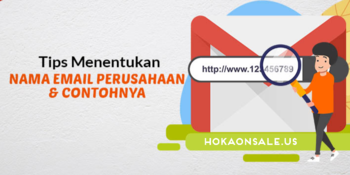
Complete Guide to Creating a Business Email
Created on 3 July, 2024 • Marketing & Business Communication • 118 views • 4 minutes read
In this article, we'll walk you through how to create a business email for free, without any conditions. As we all know, email is an effective medium for communication, whether personal or business-related. In business, using email is as common as usi
Complete Guide to Creating a Business Email
In this article, we'll walk you through how to create a business email for free, without any conditions.
As we all know, email is an effective medium for communication, whether personal or business-related. In business, using email is as common as using physical letters.
Creating a business email is essentially the same as writing a business letter. If you're familiar with writing business letters, you should find it easy to create a business email.
However, for some people, crafting a business email can be challenging. This is because schools or universities rarely teach how to write business emails.
That's why we’ve put together this article to help those struggling to write a professional business email. We'll share best practices and guide you through the process. Our hope is that after reading this article, you'll be able to write better business emails and improve your overall communication skills. This guide is based on personal experience and various sources. We hope you find it useful.
Understanding Business Email
Before diving into the main discussion, let’s briefly define what a business email is. Simply put, a business email is used for communicating with stakeholders in your business.
Typically, it follows the format yourname@yourdomain.extension. This format is also used by your colleagues within the same business. The content of a business email can vary, including promotions, partnership offers, correspondence, and other business-related matters.
Now that we understand what a business email is, let's get into the key points you should consider when drafting one.
Key Questions
Before writing your business email, it’s crucial to draft it first to avoid any mistakes. Here are some key questions to consider to make your business email effective and professional:
- Who is your audience or recipient?
- Knowing who will receive your email is essential. It determines the tone, formality, and content of your communication. For instance, the way you write to your employees will differ from how you write to your suppliers. Identifying your audience helps tailor your message appropriately.
- What is the purpose of your business email?
- Every business email should have a clear, single purpose. This is known as the "One Thing Rule," from the book "One Thing – The Surprisingly Simple Truth Behind Extraordinary Results" by Gary Keller and Jay Papasan. This rule emphasizes focusing on one main objective to make your email clear and actionable.
- Is your business email necessary?
- Determine if email is the best medium for your communication. For ongoing discussions, chat applications or phone calls might be more suitable. Ensure your email is the right channel for the message you’re sending.
- Is your business email appropriate?
- Consider whether your email is suitable for the situation and the recipient. For example, sensitive or confidential information might be better conveyed in person. Ask yourself if you’d be comfortable having your email read out loud in a meeting attended by your boss, spouse, or parent. If so, then it’s likely appropriate to send.
How to Create a Business Email
After answering the key questions, it’s time to create your business email. We’ll focus on two main aspects:
- Email Appearance
- Email Content
1. Email Appearance
A business email should be clear, concise, and professional. The appearance includes:
- Impression: Your choice of words and how you structure your sentences will create an impression on the reader. Pay attention to:
- Proper use of uppercase and lowercase letters.
- Correct punctuation.
- Moderate use of emojis.
- Format: Ensure the email is easy to read:
- Use standard, readable fonts like Open Sans, San Serif, or Roboto.
- Keep font sizes between 14px and 16px.
- Use text formatting (bold, underline, italics) appropriately.
- Limit colors to one or two for a professional look.
- Use bullet points or numbered lists for clarity.
- Include quoted text for emphasis when needed.
2. Email Content
The content is the heart of your business email. It includes:
- Subject Line: This is the first thing the recipient sees, so make it concise and compelling (ideally 3-8 words).
- Examples:
- Bad: "Amazing" / "Important information for those seeking new opportunities online without any investment"
- Good: "4 Amazing Things About Jogjakarta" / "Find New Opportunities Online Here"
- Opening Greeting: Use a simple, respectful greeting.
- "Assalamu’alaykum"
- "Dear Mr/Mrs [Recipient’s Name]"
- "Hi [Recipient’s Name]"
- Brief Introduction: Provide a short introduction to set the context.
- Purpose: Clearly state the purpose of your email. Stick to one main objective.
- Additional Information (optional): Include any relevant additional details.
- Call to Action (CTA): Include a CTA, such as a link or button, directing the recipient to take the desired action.
- Closing Message: End with a polite closing statement.
- Download Links or Attachments: If necessary, attach files or provide download links to make it easier for the recipient to access additional information.
By paying attention to both the appearance and content of your business email, you can create a professional and effective communication tool. We hope this guide helps you write better business emails. See you in the next article!
Conclusion
Creating a business email involves understanding your audience, having a clear purpose, ensuring the email is necessary and appropriate, and paying attention to both appearance and content. By following these guidelines, you can craft professional and effective business emails.